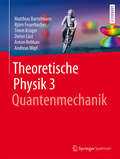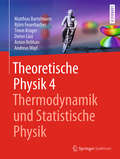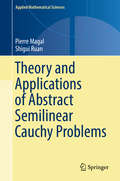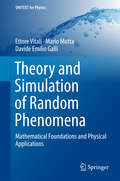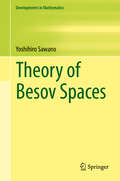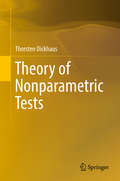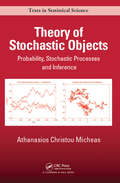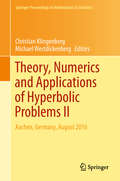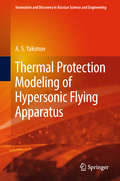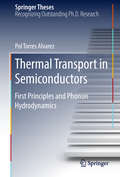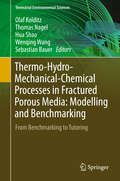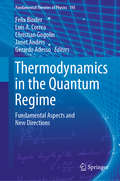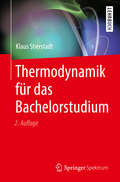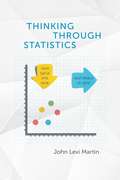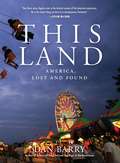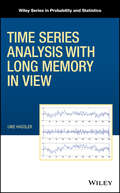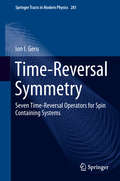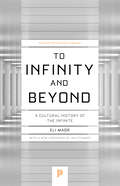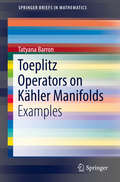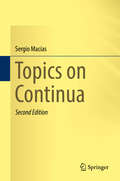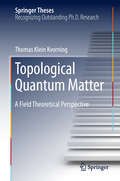- Table View
- List View
Theoretische Physik 3 | Quantenmechanik: Quantenmechanik 1
by Matthias Bartelmann Timm Krüger Björn Feuerbacher Andreas Wipf Dieter Lüst Anton RebhanDas beliebte Buch Theoretische Physik wird jetzt erstmalig in korrigierter und ergänzter Form in Einzelbänden angeboten. Das ermöglicht den Studierenden, die handlichen Bände zum Lernen, Aufgabenlösen und zum schnellen Nachschlagen leichter mitnehmen und nutzen zu können. Gleichzeitig wird die gesamte theoretische Physik des Bachelorstudiums (und darüber hinaus) in den vier Bänden aufeinander abgestimmt präsentiert. Das vorliegende Buch ist der dritte Teil der vierbändigen Reihe und deckt den Lehrstoff der Bachelorvorlesung zur Quantenmechanik großer Universitäten in Deutschland, Österreich und der Schweiz möglichst umfassend ab. Die besondere Stärke dieser Reihe liegt darin, den Leser mit einer Vielzahl von didaktischen Elementen beim Lernen zu unterstützen: -Alle Kapitel werden mit grundsätzlichen Fragen eingeleitet -Wichtige Aussagen, Formeln und Definitionen sind übersichtlich hervorgehoben -Beispiele regen zum Aktivwerden an -Selbstfragen helfen dem Leser, den behandelten Stoff zu reflektieren -„So geht’s weiter“-Abschnitte, beispielsweise über Supersymmetrie in der Quantenmechanik ermöglichen einen Blick über den Tellerrand und geben Einblicke in aktuelle Forschung -Anhand ausführlich gelöster Aufgaben kann das Gelernte überprüft und gefestigt werden -Mathematische Boxen sind zum schnellen Nachschlagen herausgehoben -Alle Bände sind durchgehend vierfarbig und mit übersichtlichen Grafiken gestaltet. Die Autoren haben ihre langjährige und vielfach hervorragend bewertete Lehrerfahrung in das Werk einfließen lassen. Darüber hinaus gelingt es ihnen, die Zusammenhänge in der Theoretischen Physik auch bandübergreifend klar werden zu lassen. Der Inhalt Die Entstehung der Quantenphysik – Wellenmechanik – Formalismus der Quantenmechanik – Observablen, Zustände und Unbestimmtheit – Zeitentwicklung und Bilder – Eindimensionale Quantensysteme – Symmetrien und Erhaltungssätze – Zentralkräfte, das Wasserstoffatom – Elektromagnetische Felder und der Spin – Störungstheorie und Virialsatz – Mehrteilchensysteme und weitere Näherungsmethoden – Streutheorie
Theoretische Physik 4 | Thermodynamik und Statistische Physik
by Matthias Bartelmann Timm Krüger Björn Feuerbacher Andreas Wipf Dieter Lüst Anton RebhanDas beliebte Buch Theoretische Physik wird jetzt erstmalig in korrigierter und ergänzter Form in Einzelbänden angeboten. Das ermöglicht den Studierenden, die handlichen Bände zum Lernen, Aufgabenlösen und zum schnellen Nachschlagen leichter mitnehmen und nutzen zu können. Gleichzeitig wird die gesamte theoretische Physik des Bachelorstudiums (und darüber hinaus) in den vier Bänden aufeinander abgestimmt präsentiert. Das vorliegende Buch ist der vierte Teil der vierbändigen Reihe und deckt den Lehrstoff der Bachelorvorlesung zur Thermodynamik und Statistischen Physik großer Universitäten in Deutschland, Österreich und der Schweiz möglichst umfassend ab. Die besondere Stärke dieser Reihe liegt darin, den Leser mit einer Vielzahl von didaktischen Elementen beim Lernen zu unterstützen: -Alle Kapitel werden mit grundsätzlichen Fragen eingeleitet -Wichtige Aussagen, Formeln und Definitionen sind übersichtlich hervorgehoben -Beispiele regen zum Aktivwerden an -Selbstfragen helfen dem Leser, den behandelten Stoff zu reflektieren -„So geht’s weiter“-Abschnitte, beispielsweise über das Curie-Weiss-Modell, Weiße Zwerge und Systeme außerhalb des Gleichgewichts ermöglichen einen Blick über den Tellerrand und geben Einblicke in aktuelle Forschung -Anhand ausführlich gelöster Aufgaben kann das Gelernte überprüft und gefestigt werden -Mathematische Boxen sind zum schnellen Nachschlagen herausgehoben -Alle Bände sind durchgehend vierfarbig und mit übersichtlichen Grafiken gestaltet. Die Autoren haben ihre langjährige und vielfach hervorragend bewertete Lehrerfahrung in das Werk einfließen lassen. Darüber hinaus gelingt es ihnen, die Zusammenhänge in der Theoretischen Physik auch bandübergreifend klar werden zu lassen. Der Inhalt Phänomenologische Begründung der Thermodynamik – Statistische Begründung der Thermodynamik – Einfache thermodynamische Anwendungen – Ensembles und Zustandssummen – Quantenstatistik
Theory and Applications of Abstract Semilinear Cauchy Problems (Applied Mathematical Sciences #201)
by Pierre Magal Shigui RuanSeveral types of differential equations, such as functional differential equation, age-structured models, transport equations, reaction-diffusion equations, and partial differential equations with delay, can be formulated as abstract Cauchy problems with non-dense domain. This monograph provides a self-contained and comprehensive presentation of the fundamental theory of non-densely defined semilinear Cauchy problems and their applications. Starting from the classical Hille-Yosida theorem, semigroup method, and spectral theory, this monograph introduces the abstract Cauchy problems with non-dense domain, integrated semigroups, the existence of integrated solutions, positivity of solutions, Lipschitz perturbation, differentiability of solutions with respect to the state variable, and time differentiability of solutions. Combining the functional analysis method and bifurcation approach in dynamical systems, then the nonlinear dynamics such as the stability of equilibria, center manifold theory, Hopf bifurcation, and normal form theory are established for abstract Cauchy problems with non-dense domain. Finally applications to functional differential equations, age-structured models, and parabolic equations are presented. This monograph will be very valuable for graduate students and researchers in the fields of abstract Cauchy problems, infinite dimensional dynamical systems, and their applications in biological, chemical, medical, and physical problems.
Theory and Simulation of Random Phenomena: Mathematical Foundations and Physical Applications (UNITEXT for Physics)
by Ettore Vitali Mario Motta Davide Emilio GalliThe purpose of this book is twofold: first, it sets out to equip the reader with a sound understanding of the foundations of probability theory and stochastic processes, offering step-by-step guidance from basic probability theory to advanced topics, such as stochastic differential equations, which typically are presented in textbooks that require a very strong mathematical background. Second, while leading the reader on this journey, it aims to impart the knowledge needed in order to develop algorithms that simulate realistic physical systems. Connections with several fields of pure and applied physics, from quantum mechanics to econophysics, are provided. Furthermore, the inclusion of fully solved exercises will enable the reader to learn quickly and to explore topics not covered in the main text. The book will appeal especially to graduate students wishing to learn how to simulate physical systems and to deepen their knowledge of the mathematical framework, which has very deep connections with modern quantum field theory.
Theory of Besov Spaces (Developments in Mathematics #56)
by Yoshihiro SawanoThis is a self-contained textbook of the theory of Besov spaces and Triebel–Lizorkin spaces oriented toward applications to partial differential equations and problems of harmonic analysis. These include a priori estimates of elliptic differential equations, the T1 theorem, pseudo-differential operators, the generator of semi-group and spaces on domains, and the Kato problem. Various function spaces are introduced to overcome the shortcomings of Besov spaces and Triebel–Lizorkin spaces as well. The only prior knowledge required of readers is familiarity with integration theory and some elementary functional analysis.Illustrations are included to show the complicated way in which spaces are defined. Owing to that complexity, many definitions are required. The necessary terminology is provided at the outset, and the theory of distributions, L^p spaces, the Hardy–Littlewood maximal operator, and the singular integral operators are called upon. One of the highlights is that the proof of the Sobolev embedding theorem is extremely simple. There are two types for each function space: a homogeneous one and an inhomogeneous one. The theory of function spaces, which readers usually learn in a standard course, can be readily applied to the inhomogeneous one. However, that theory is not sufficient for a homogeneous space; it needs to be reinforced with some knowledge of the theory of distributions. This topic, however subtle, is also covered within this volume. Additionally, related function spaces—Hardy spaces, bounded mean oscillation spaces, and Hölder continuous spaces—are defined and discussed, and it is shown that they are special cases of Besov spaces and Triebel–Lizorkin spaces.
Theory of Nonparametric Tests
by Thorsten DickhausThis textbook provides a self-contained presentation of the main concepts and methods of nonparametric statistical testing, with a particular focus on the theoretical foundations of goodness-of-fit tests, rank tests, resampling tests, and projection tests. The substitution principle is employed as a unified approach to the nonparametric test problems discussed. In addition to mathematical theory, it also includes numerous examples and computer implementations. The book is intended for advanced undergraduate, graduate, and postdoc students as well as young researchers. Readers should be familiar with the basic concepts of mathematical statistics typically covered in introductory statistics courses.
Theory of Stochastic Objects: Probability, Stochastic Processes and Inference (Chapman & Hall/CRC Texts in Statistical Science)
by Athanasios Christou MicheasThis book defines and investigates the concept of a random object. To accomplish this task in a natural way, it brings together three major areas; statistical inference, measure-theoretic probability theory and stochastic processes. This point of view has not been explored by existing textbooks; one would need material on real analysis, measure and probability theory, as well as stochastic processes - in addition to at least one text on statistics- to capture the detail and depth of material that has gone into this volume. Presents and illustrates ‘random objects’ in different contexts, under a unified framework, starting with rudimentary results on random variables and random sequences, all the way up to stochastic partial differential equations. Reviews rudimentary probability and introduces statistical inference, from basic to advanced, thus making the transition from basic statistical modeling and estimation to advanced topics more natural and concrete. Compact and comprehensive presentation of the material that will be useful to a reader from the mathematics and statistical sciences, at any stage of their career, either as a graduate student, an instructor, or an academician conducting research and requiring quick references and examples to classic topics. Includes 378 exercises, with the solutions manual available on the book's website. 121 illustrative examples of the concepts presented in the text (many including multiple items in a single example). The book is targeted towards students at the master’s and Ph.D. levels, as well as, academicians in the mathematics, statistics and related disciplines. Basic knowledge of calculus and matrix algebra is required. Prior knowledge of probability or measure theory is welcomed but not necessary.
Theory, Numerics and Applications of Hyperbolic Problems I: Aachen, Germany, August 2016 (Springer Proceedings in Mathematics & Statistics #236)
by Christian Klingenberg Michael WestdickenbergThe first of two volumes, this edited proceedings book features research presented at the XVI International Conference on Hyperbolic Problems held in Aachen, Germany in summer 2016. It focuses on the theoretical, applied, and computational aspects of hyperbolic partial differential equations (systems of hyperbolic conservation laws, wave equations, etc.) and of related mathematical models (PDEs of mixed type, kinetic equations, nonlocal or/and discrete models) found in the field of applied sciences.
Theory, Numerics and Applications of Hyperbolic Problems II: Aachen, Germany, August 2016 (Springer Proceedings in Mathematics & Statistics #237)
by Christian Klingenberg Michael WestdickenbergThe second of two volumes, this edited proceedings book features research presented at the XVI International Conference on Hyperbolic Problems held in Aachen, Germany in summer 2016. It focuses on the theoretical, applied, and computational aspects of hyperbolic partial differential equations (systems of hyperbolic conservation laws, wave equations, etc.) and of related mathematical models (PDEs of mixed type, kinetic equations, nonlocal or/and discrete models) found in the field of applied sciences.
Thermal Protection Modeling of Hypersonic Flying Apparatus (Innovation And Discovery In Russian Science And Engineering Ser.)
by A. S. YakimovThis book is devoted to studies of unsteady heat and mass exchange processes taking into account thermochemical destruction of thermal protective materials, research of transpiration cooling systems, thermal protection of composite materials exposed to low-energy disturbances, as well as the numerical solution of heat and mass transfer of the exchange. It proposes several mathematical models of passive and active thermal protection systems with regard to factors such as surface ablation, surface roughness, phase transition of a liquid in porous materials, rotation of the body around its longitudinal axis, and exposure to low-energy disturbances. The author studies the possibilities to control thermochemical destruction and heat mass exchange processes in transpiration cooling systems exposed to low-energy disturbances. The numerical analysis of the heat and mass exchange process in carbon plastics under repeated impulse action is also presented. The numerical solutions of problems are compared with the known experimental data. The book is intended for specialists in the field of thermal protection and heat mass exchange, as well as graduate and undergraduates in physics and mathematics.
Thermal Transport in Semiconductors: First Principles and Phonon Hydrodynamics (Springer Theses)
by Pol Torres AlvarezStarting from a broad overview of heat transport based on the Boltzmann Transport Equation, this book presents a comprehensive analysis of heat transport in bulk and nanomaterials based on a kinetic-collective model (KCM). This has become key to understanding the field of thermal transport in semiconductors, and represents an important stride. The book describes how heat transport becomes hydrodynamic at the nanoscale, propagating very much like a viscous fluid and manifesting vorticity and friction-like behavior. It introduces a generalization of Fourier’s law including a hydrodynamic term based on collective behavior in the phonon ensemble. This approach makes it possible to describe in a unifying way recent experiments that had to resort to unphysical assumptions in order to uphold the validity of Fourier’s law, demonstrating that hydrodynamic heat transport is a pervasive type of behavior in semiconductors at reduced scales.
Thermo-Hydro-Mechanical-Chemical Processes in Fractured Porous Media: From Benchmarking To Tutoring (Terrestrial Environmental Sciences Ser.)
by Thomas Nagel Olaf Kolditz Hua Shao Wenqing Wang Sebastian BauerThe book comprises the 3rd collection of benchmarks and examples for porous and fractured media mechanics. Analysis of thermo-hydro-mechanical-chemical (THMC) processes is essential to a wide area of applications in environmental engineering, such as geological waste deposition, geothermal energy utilization (shallow and deep systems), carbon capture and storage (CCS) as well as water resources management and hydrology. In order to assess the feasibility, safety as well as sustainability of geoenvironmental applications, model-based simulation is the only way to quantify future scenarios. This charges a huge responsibility concerning the reliability of conceptual models and computational tools. Benchmarking is an appropriate methodology to verify the quality and validate the concept of models based on best practices. Moreover, benchmarking and code comparison are building strong community links. The 3rd THMC benchmark book also introduces benchmark-based tutorials, therefore the subtitle is selected as “From Benchmarking to Tutoring”. The benchmark book is part of the OpenGeoSys initiative - an open source project to share knowledge and experience in environmental analysis and scientific computation. The new version of OGS-6 is introduced and first benchmarks are presented therein (see appendices).
Thermodynamics in the Quantum Regime: Fundamental Aspects and New Directions (Fundamental Theories of Physics #195)
by Gerardo Adesso Felix Binder Luis A. Correa Christian Gogolin Janet AndersQuantum Thermodynamics is a novel research field which explores the emergence of thermodynamics from quantum theory and addresses thermodynamic phenomena which appear in finite-size, non-equilibrium and finite-time contexts. Blending together elements from open quantum systems, statistical mechanics, quantum many-body physics, and quantum information theory, it pinpoints thermodynamic advantages and barriers emerging from genuinely quantum properties such as quantum coherence and correlations. Owing to recent experimental efforts, the field is moving quickly towards practical applications, such as nano-scale heat devices, or thermodynamically optimised protocols for emergent quantum technologies. Starting from the basics, the present volume reviews some of the most recent developments, as well as some of the most important open problems in quantum thermodynamics. The self-contained chapters provide concise and topical introductions to researchers who are new to the field. Experts will find them useful as a reference for the current state-of-the-art. In six sections the book covers topics such as quantum heat engines and refrigerators, fluctuation theorems, the emergence of thermodynamic equilibrium, thermodynamics of strongly coupled systems, as well as various information theoretic approaches including Landauer's principle and thermal operations. It concludes with a section dedicated to recent quantum thermodynamics experiments and experimental prospects on a variety of platforms ranging from cold atoms to photonic systems, and NV centres.
Thermodynamik für das Bachelorstudium
by Klaus StierstadtDas Verständnis der Thermodynamik ist nicht nur Voraussetzung für die moderne Physik, Chemie, Biologie und Technik, sondern auch für die Frage der Energieversorgung der Zukunft. Der Autor führt in die Prinzipien, Methoden und Ergebnisse der Thermodynamik ein, indem er die Größen Temperatur, Wärme und Entropie auf die Eigenschaften der Atome und auf ihr Zusammenwirken zurückgeführt. Basierend auf den vier Hauptsätzen der Thermodynamik werden die wichtigsten Anwendungen, z. B. Energieumwandlung und Nanotechnologie, ausführlich besprochen.
Thermodynamik für das Bachelorstudium
by Klaus StierstadtDas Verständnis der Thermodynamik ist nicht nur Voraussetzung für die moderne Physik, Chemie, Biologie und Technik, sondern auch für die Frage der Energieversorgung der Zukunft. Der Autor führt in die Prinzipien, Methoden und Ergebnisse der Thermodynamik ein, indem er die Größen Temperatur, Wärme und Entropie auf die Eigenschaften der Atome und auf ihr Zusammenwirken zurückgeführt. Basierend auf den vier Hauptsätzen der Thermodynamik werden die wichtigsten Anwendungen, z. B. Energieumwandlung und Nanotechnologie, ausführlich besprochen.
Thinking Through Statistics
by John Levi MartinSimply put, Thinking Through Statistics is a primer on how to maintain rigorous data standards in social science work, and one that makes a strong case for revising the way that we try to use statistics to support our theories. But don’t let that daunt you. With clever examples and witty takeaways, John Levi Martin proves himself to be a most affable tour guide through these scholarly waters. Martin argues that the task of social statistics isn't to estimate parameters, but to reject false theory. He illustrates common pitfalls that can keep researchers from doing just that using a combination of visualizations, re-analyses, and simulations. Thinking Through Statistics gives social science practitioners accessible insight into troves of wisdom that would normally have to be earned through arduous trial and error, and it does so with a lighthearted approach that ensures this field guide is anything but stodgy.
This Land: America, Lost and Found
by Dan BarryA landmark collection by New York Times journalist Dan Barry, selected from a decade of his distinctive "This Land" columns and presenting a powerful but rarely seen portrait of America. In the wake of Hurricane Katrina and on the eve of a national recession, New York Times writer Dan Barry launched a column about America: not the one populated only by cable-news pundits, but the America defined and redefined by those who clean the hotel rooms, tend the beet fields, endure disasters both natural and manmade. As the name of the president changed from Bush to Obama to Trump, Barry was crisscrossing the country, filing deeply moving stories from the tiniest dot on the American map to the city that calls itself the Capital of the World. Complemented by the select images of award-winning Times photographers, these narrative and visual snapshots of American life create a majestic tapestry of our shared experience, capturing how our nation is at once flawed and exceptional, paralyzed and ascendant, as cruel and violent as it can be gentle and benevolent.
Time Series Analysis with Long Memory in View (Wiley Series in Probability and Statistics #215)
by Uwe HasslerProvides a simple exposition of the basic time series material, and insights into underlying technical aspects and methods of proof Long memory time series are characterized by a strong dependence between distant events. This book introduces readers to the theory and foundations of univariate time series analysis with a focus on long memory and fractional integration, which are embedded into the general framework. It presents the general theory of time series, including some issues that are not treated in other books on time series, such as ergodicity, persistence versus memory, asymptotic properties of the periodogram, and Whittle estimation. Further chapters address the general functional central limit theory, parametric and semiparametric estimation of the long memory parameter, and locally optimal tests. Intuitive and easy to read, Time Series Analysis with Long Memory in View offers chapters that cover: Stationary Processes; Moving Averages and Linear Processes; Frequency Domain Analysis; Differencing and Integration; Fractionally Integrated Processes; Sample Means; Parametric Estimators; Semiparametric Estimators; and Testing. It also discusses further topics. This book: Offers beginning-of-chapter examples as well as end-of-chapter technical arguments and proofs Contains many new results on long memory processes which have not appeared in previous and existing textbooks Takes a basic mathematics (Calculus) approach to the topic of time series analysis with long memory Contains 25 illustrative figures as well as lists of notations and acronyms Time Series Analysis with Long Memory in View is an ideal text for first year PhD students, researchers, and practitioners in statistics, econometrics, and any application area that uses time series over a long period. It would also benefit researchers, undergraduates, and practitioners in those areas who require a rigorous introduction to time series analysis.
Time-Reversal Symmetry: Seven Time-Reversal Operators for Spin Containing Systems (Springer Tracts in Modern Physics #281)
by Ion I. GeruThis book introduces new developments in the field of Time-Reversal Symmetry presenting, for the first time, the Wigner time-reversal operator in the form of a product of two- or three time-reversal operators of lower symmetry. The action of these operators leads to the sign change of only one or two angular momentum components, not of all of them. It demonstrates that there are six modes of time-reversal symmetry breaking that do not lead to the complete disappearance of the symmetry but to its lowering. The full restoration of the time-reversal symmetry in the six cases mentioned is possible by introducing six types of metaparticles. The book also confirms the presence of six additional time-reversal operators using a group-theoretical method. The problem is only where to seek these metaparticles. The book discusses time-reversal symmetry in classical mechanics, classical and relativistic electrodynamics, quantum mechanics and theory of quantized fields, including dynamical reversibility and statistical irreversibility of the time, Wigner’s and Herring’s criteria, Kramers theorem, selection rules due to time-reversal symmetry, Onsager’s relations, Poincaré recurrence theorem, and CPT theorem. It particularly focuses attention on time-reversal symmetry violation. It is proposed a new method of testing the time-reversal symmetry, which is confirmed experimentally by EPR spectroscopy data. It shows that the traditional black-white point groups of magnetic symmetry are not applicable to magnetic systems with Kramers degeneration of energy levels and that magnetic groups of four-color symmetry are adequate for them. Further, it addresses the predicted structural distortions in Kramers three-homonuclear magnetic clusters due to time-reversal symmetry that have been identified experimentally. Lastly, it proposes a method of synthesis of two-nuclear coordination compounds with predictable magnetic properties, based on the application of the time-reversal transformation that was confirmed experimentally.
To Infinity and Beyond: A Cultural History of the Infinite
by Eli MaorTo Infinity and Beyond explores the idea of infinity in mathematics and art. <p><p>Eli Maor examines the role of infinity, as well as its cultural impact on the arts and sciences. He evokes the profound intellectual impact the infinite has exercised on the human mind—from the horror infiniti of the Greeks to the works of M. C. Escher; from the ornamental designs of the Moslems, to the sage Giordano Bruno, whose belief in an infinite universe led to his death at the hands of the Inquisition. But above all, the book describes the mathematician's fascination with infinity—a fascination mingled with puzzlement.
Toeplitz Operators on Kähler Manifolds: Examples (SpringerBriefs in Mathematics)
by Tatyana BarronThe purpose of this Brief is to give a quick practical introduction into the subject of Toeplitz operators on Kähler manifolds, via examples, worked out carefully and in detail. Necessary background is included. Several theorems on asymptotics of Toeplitz operators are reviewed and illustrated by examples, including the case of tori and the 2-dimensional sphere. Applications in the context of multisymplectic and hyperkähler geometry are discussed. The book is suitable for graduate students, advanced undergraduate students, and any researchers.
Topics on Continua
by Sergio MacíasThis book is a significant companion text to the existing literature on continuum theory. It opens with background information of continuum theory, so often missing from the preceding publications, and then explores the following topics: inverse limits, the Jones set function T, homogenous continua, and n-fold hyperspaces. In this new edition of the book, the author builds on the aforementioned topics, including the unprecedented presentation of n-fold hyperspace suspensions and induced maps on n-fold hyperspaces. The first edition of the book has had a remarkable impact on the continuum theory community. After twelve years, this updated version will also prove to be an excellent resource within the field of topology.
Topological Methods in Group Theory (London Mathematical Society Lecture Note Series #451)
by J. F. Lafont N. Broaddus M. Davis I. J. OrtizThis volume collects the proceedings of the conference 'Topological methods in group theory', held at Ohio State University in 2014 in honor of Ross Geoghegan's 70th birthday. It consists of eleven peer-reviewed papers on some of the most recent developments at the interface of topology and geometric group theory. The authors have given particular attention to clear exposition, making this volume especially useful for graduate students and for mathematicians in other areas interested in gaining a taste of this rich and active field. A wide cross-section of topics in geometric group theory and topology are represented, including left-orderable groups, groups defined by automata, connectivity properties and Σ-invariants of groups, amenability and non-amenability problems, and boundaries of certain groups. Also included are topics that are more geometric or topological in nature, such as the geometry of simplices, decomposition complexity of certain groups, and problems in shape theory.
Topological Quantum Matter
by Thomas Klein KvorningThis book offers a theoretical description of topological matter in terms of effective field theories, and in particular topological field theories, focusing on two main topics: topological superconductors and topological insulators.Even though there is vast literature on these subjects, the book fills an important gap by providing a concise introduction to both topological order and symmetry-protected phases using a modern mathematical language, and developing the theoretical concepts by highlighting the physics and the physical properties of the systems. Further, it discusses in detail the topological interactions for topologically ordered matter, and the response to smooth external fields for symmetry protected matter. The book also covers more specialized topics that cannot be found elsewhere. Specifically, the response of superconductors to geometry, including the newly discovered geo-Meissner effect; and a correction to the usual Meissner effect, only present in the topologically interesting chiral superconductors.
Topological and Non-Topological Solitons in Scalar Field Theories (Cambridge Monographs on Mathematical Physics)
by Yakov M. ShnirSolitons emerge in various non-linear systems as stable localized configurations, behaving in many ways like particles, from non-linear optics and condensed matter to nuclear physics, cosmology and supersymmetric theories. This book provides an introduction to integrable and non-integrable scalar field models with topological and non-topological soliton solutions. Focusing on both topological and non-topological solitons, it brings together debates around solitary waves and construction of soliton solutions in various models and provides a discussion of solitons using simple model examples. These include the Kortenweg-de-Vries system, sine-Gordon model, kinks and oscillons, and skyrmions and hopfions. The classical field theory of scalar field in various spatial dimensions is used throughout the book in presentation of related concepts, both at the technical and conceptual level. Providing a comprehensive introduction to the description and construction of solitons, this book is ideal for researchers and graduate students in mathematics and theoretical physics.
